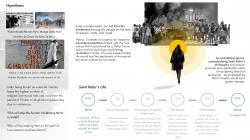India being famed as a secular country faces vast number of religion/communal riots and wars from the period of Cholas to Mughals till present day.
Who will stop the human intolerance terror in India? Will it be a person, civil groups, journalists, politicians, industrialists or saints?
Looking back, many saints and leaders played the role of peacemakers and educated people in India about spiritual values that one must adapt in their life. In current India, there seems to be an extreme lack of brotherhood and unity among the people of different caste/creed/religion.
“We are not makers of history. We are made by history.”
- Martin Luther King Jr.
It is said we must never forget our roots. Remembering the 15th century mystic saints like Kabir of Banaras (Varanasi), played a vital role during the Bhakti movement in India (as witnessed in below chart). The saint who showed the path towards one true God and supported no particular religion.
The religious conflicts were at peak and only when Saint Kabir came forward and changed the perspective of not only the general people but even the rulers like Akbar; creating a massively positive impact, especially in large parts of the north. Kabir was a fakir who did not materialize in his life. He did not preach the idol, like the crowd. His teachings were not inclined towards one particular religion, saint or gurus but only on the path of Truth. He proclaimed; God is “neither in Kaaba nor in Kailash.”
While understanding Kabir’s philosophy towards humanity, ‘a wide range of mystic emotion is brought into play: from the loftiest abstractions, the most otherworldly passion for the Infinite, to the most intimate and personal realization of God, expressed in homely metaphors and religious symbols drawn indifferently from Hindu and Mohammedan belief.’ as introduced by Evelyn Underhill in the book ‘Songs of Kabir’ by R. Tagore.
Kabir is also known as “at once the child of Allah and Ram.” Kabir through his eclecticism symbols God as the root and says, “happiness shall be yours when you come to the root.” He usually makes metaphorical representations to teach people like:
‘More over every human can hear the brahma, “the source of all music” plays.’
‘..seen without sight the effulgence of Brahma.’
‘..the whole creation is full of music and it can be heard from home as well as in heaven.’
A legend says, after his death the Muslim and Hindu disciples disputed the possession of his body, as they argued, Kabir appeared before them and told them to lift the shroud and look at that which lay beneath. There were flowers, half of which were buried by the Muslims and half burnt by the Hindus - a fitting conclusion to a life which made a high impression on two different creeds of time.
The drop in promotion of secularism began after the arrival of British in India. “...I do think we would ever conquer this country, unless we break the very backbone of this nation, which is her spiritual and cultural heritage and therefore, I propose that we replace her old and ancient education system, her culture….” one of the most disputed quotes in British-India history by Thomas Macaulay. The authenticity of this statement has a blanket of mystery. But somewhere it turned into reality of India as its spiritual and cultural values started diminishing with no upfront person, groups, saints or political leaders fighting for it.
Leaders like Mahatma Gandhi and B.R Ambedkar tried to promote secularism in India. They did succeed to some extent but their message, teachings and voice was not enough and started fading away by the 21st century. India has seen multiple religion/discrimination-based riots like The Bengal Partition, Moplah Rebellion, Communal Violence, Bhagalpur riots, Anti-Sikh riots, etc. and many more taking shape.
Today, India is independent, but not from the riots and fights among the people on the basis of religion, caste, and creed. Hence, it creates an urgency for means to educate/aware/train citizens with the true values that must prevail for a better future. Kabir and his teachings would bring revolution in India, if he was present today. He would hurt the sentiments of thousands but teach millions by his words.
Project Vision:
Manifesting Kabir’s lost philosophies of peace and secularism by creating an architecture space.
Identified Site:
Kabir spent his last days and died in Maghar, Uttar Pradesh. On his death, the followers, unfortunately divided in group of Hindus and Muslims, fought over his body cremation procedure. And the result was two monuments, namely Kabir Mazar and Samadhi. These symbolic structures and the ironical reality of Kabir’s philosophy (after his death) creates a perfect context to the project. Thus, site study is done in the same premise and where the project is also proposed.
Conclusion:
In today’s difficult time, in India, it will be truly important to make people aware about the dying secularism and rising intolerance among humans. The architecture which would evolve from Kabir’s philosophy will play that role and create a positive impact on people’s spiritual self.
2020
2021
Institution area: 5455 sq.mt
Institution structure:
1. Awareness (Line of awakening, workshop, and training)
2. Academia (School of philosophy, school of performing arts)
3. Documentation
4. Research
Parshva R. Shah
Supervisor:
Prof. Niraj D. Naik




















